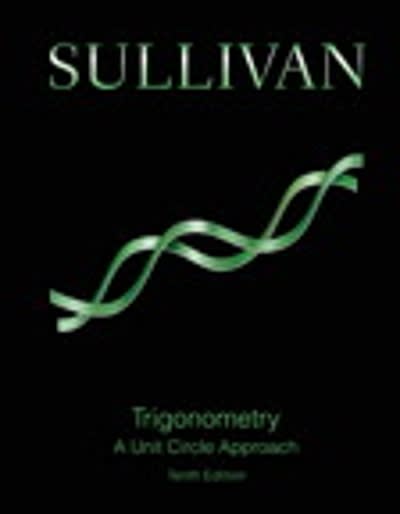Question
1. The time required to assemble an electronic component is normally distributed with a mean and a standard deviation of 29 minutes and 11 minutes,
1. The time required to assemble an electronic component is normally distributed with a mean and a standard deviation of 29 minutes and 11 minutes, respectively. [You may find it useful to reference the z table.] a. Find the probability that a randomly picked assembly takes between 18 and 30 minutes. (Round your final answer to 4 decimal places.)
b. It is unusual for the assembly time to be above 44 minutes or below 16 minutes. What proportion of assembly times fall in these unusual categories? (Round your final answer to 4 decimal places.)
2.Find the following z values for the standard normal variable Z. (You may find it useful to reference the z table. Negative values should be indicated by a minus sign. Round your answers to 2 decimal places.)
3. A random variable X follows the uniform distribution with a lower limit of 550 and an upper limit of 600. a.Calculate the mean and the standard deviation for the distribution. (Round intermediate calculation for standard deviation to 4 decimal places and final answer to 2 decimal places.)
b.What is the probability that X is less than 560? (Round intermediate calculations to at least 4 decimal places and final answer to 2 decimal places.)
4.The arrival time of an elevator in a 12-story dormitory is equally likely at any time during the next 4.6 minutes. a.Calculate the expected arrival time. (Round your answer to 2 decimal places.)
b.What is the probability that an elevator arrives in less than 3.5 minutes? (Round intermediate calculations to at least 4 decimal places and final answer to 3 decimal places.)
c. What is the probability that the wait for an elevator is more than 3.5 minutes? (Round intermediate calculations to at least 4 decimal places and final answer to 3 decimal places.)
5. Let X be normally distributed with mean = 3,800 and standard deviation = 1,600. [You may find it useful to reference the z table.] a.Find x such that P(X x) = 0.9382. (Round your final answer to nearest whole number.)
b. Find x such that P(X > x) = 0.025. (Round your final answer to nearest whole number.)
c. Find x such that P(3,800 X x) = 0.1217. (Round your final answer to nearest whole number.) d.Find x such that P(X x) = 0.4840. (Round your final answer to nearest whole number.)
6.According to a company's website, the top 15% of the candidates who take the entrance test will be called for an interview. The reported mean and standard deviation of the test scores are 68 and 7, respectively. If test scores are normally distributed, what is the minimum score required for an interview? (You may find it useful to reference the z table. Round your final answer to 2 decimal places.)
7. A packaging system fills boxes to an average weight of 17 ounces with a standard deviation of 0.5 ounce. It is reasonable to assume that the weights are normally distributed. Calculate the 1st, 2nd, and 3rd quartiles of the box weight. (You may find it useful to reference the z table. Round your final answers to 2 decimal places.)
8.A random variable X follows the continuous uniform distribution with a lower bound of 4 and an upper bound of 6. a. What is the height of the density function f(x)? (Round your answer to 4 decimal places.) b. .What are the mean and the standard deviation for the distribution? (Round your answers to 2 decimal places.)
c.Calculate P(X 2). (Round intermediate calculations toat least 4 decimal places and final answer to 4 decimal places.)
7. You are considering the risk-return profile of two mutual funds for investment. The relatively risky fund promises an expected return of 10.3% with a standard deviation of 17.8%. The relatively less risky fund promises an expected return and standard deviation of 4% and 6%, respectively. Assume that the returns are approximately normally distributed. [You may find it useful to reference the z table.] a-1. Calculate the probability of earning a negative return for each fund. (Round your final answers to 4 decimal places.)
a-2. Which mutual fund will you pick if your objective is to minimize the probability of earning a negative return? multiple choice 1
- Riskier fund
- Less risky fund
b-1. Calculate the probability of earning a return above 11.4% for each fund. (Round your final answers to 4 decimal places.)
b-2. Which mutual fund will you pick if your objective is to maximize the probability of earning a return above 11.4%?
- Less risky fund
- Riskier fund
8. Let X be normally distributed with mean =144 and standard deviation =16. [You may find it useful to reference the z table.] a. Find P(X 100). (Round your final answer to 4 decimal places.)
b. Find P(95 X 110). (Round your final answer to 4 decimal places.)
c. Find x such that P(X x) = 0.430. (Round your final answer to 3 decimal places.)
d. Find x such that P(X > x) = 0.870. (Round your final answer to 3 decimal places.)
Step by Step Solution
There are 3 Steps involved in it
Step: 1

Get Instant Access to Expert-Tailored Solutions
See step-by-step solutions with expert insights and AI powered tools for academic success
Step: 2

Step: 3

Ace Your Homework with AI
Get the answers you need in no time with our AI-driven, step-by-step assistance
Get Started


